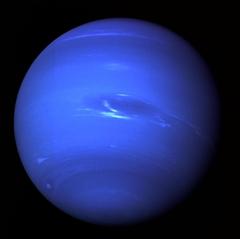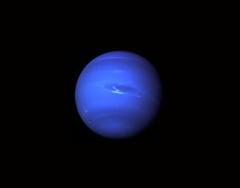URL: https://www.desy.de/news/news_search/index_eng.html
Breadcrumb Navigation
DESY News: High-pressure experiments provide insight into icy planets
News
News from the DESY research centre
High-pressure experiments provide insight into icy planets
An international team of scientists has been using X-rays to take a look inside distant ice planets. At the Extreme Conditions Beamline of DESY’s X-ray radiation source PETRA III, the team investigated how water ice behaves at high pressure, under conditions corresponding to those inside the planet Neptune, for example. At pressures up to almost two million times atmospheric pressure at sea level on Earth, the researchers were able to observe in unparalleled detail how water ice behaves under compression. The team, led by Hauke Marquardt from the University of Oxford, is presenting its findings in the scientific journal Physical Review B.

Inside the planet Neptune, a mantle of water ice, methane ice, and ammonia ice is thought to exist. Credit: NASA Linkhttps://photojournal.jpl.nasa.gov/catalog/PIA01492
In this type of experiment, water (ice) is compressed in a small high-pressure cell between the flattened tips of two specially cut diamonds. The internal structure of the high-pressure ice can be determined from the way it diffracts the incident X-rays. So far, scientists know of 17 different types of water ice, each having a different crystal structure. These phases are referred to by Roman numerals, as ice Ih and ice Ic through ice II to ice XVI. At room temperature, for example, water first becomes ice VI at about 10,000 times atmospheric pressure, then ice VII and then ice X as the pressure increases.

Ice at room temperature: A mixture of water ice and liquid water in a high-pressure cell at a temperature around 25 degrees Celsius and a pressure of one gigapascal, which corresponds to 10 000 times atmospheric pressure. Credit: DESY, Hanns-Peter Liermann
“One of our key findings is that the compression behaviour changes noticeably at certain pressures,” explains Alba San José Méndez, the lead author, who works at DESY and the University of Bayreuth. “We attribute this to a subtle change in the lattice position of the hydrogen atoms. Previous studies had noted these changes too, but were unable to establish a direct link to the compression behaviour of water ice.” Among other things, the data show a marked change in compression behaviour during the transition from ice VII to ice X, suggesting that transition states exist with clearly defined compression behaviour. The data also corroborate the very strong resistance to compression of ice X.
“These findings are important when it comes to modelling the internal dynamics of ice giants, which is substantially determined by the compression behaviour of the prevailing materials,” says co-author Hanns-Peter Liermann, who is in charge of the Extreme Conditions Beamline P02.2 at DESY. “They are also of interest in terms of the fundamental understanding of planetary ices at high pressures and the way in which small changes in the position of the hydrogen atoms affect their physical behaviour.” The scientists are now planning to carry out their novel experiments at high temperatures, to simulate conditions inside planets even more realistically. The work is part of the Early Science Program at the Centre for Molecular Water Science (CMWS) that is currently being set up at DESY and was conducted within the framework of Research Unit 2440, “Matter under Planetary Interior Conditions”, funded by the German Research Foundation (DFG).
Reference:
Bulk modulus of H2O across the ice VII–ice X transition measured by time-resolved x-ray diffraction in dynamic diamond anvil cell experiments; A. S. J. Méndez, F. Trybel, R. J. Husband, G. Steinle-Neumann, H.-P. Liermann, and H. Marquardt; Physical Review B, 2021; DOI: 10.1103/PhysRevB.103.064104




